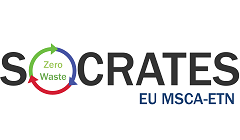SIM² KU Leuven researchers from the SREMAT Group have published a milestone paper in Frontiers of Chemical Science and Engineering on the transformation process of fayalitic slag into Fe-Si rich inorganic polymers.
Inorganic polymers
Inorganic polymers are attracting higher interest over the years as alternative construction materials, among others due to their capacity to accommodate industrial residues. Professor Yiannis Pontikes’ research group SREMat has been looking at this aspect for about 7 years. Different waste residues have been used by SREMat in making inorganic polymers with competitive characteristics. Importantly, the research has broadened towards other classes of residues, i. e. Fe-Si reach residues, instead of the common Al-Si ones. The current paper focusses on the impact of the curing condition on leaching and mechanical properties of Fe-Si rich inorganic polymers. Additionally, the paper reveals how a partly amorphous slag grain dissolves in an alkaline environment. It is revealed that curing conditions strongly affect the mechanical properties while leaching of heavy metals is influenced by a number of factors. Nevertheless, for certain curing conditions and inorganic polymer mix design, As, Cr, Ni and Pb were incorporated and leaching levels were below the national limits. The paper was published in the journal of Frontiers of Chemical Science and Engineering and is available online.
Key date paper and authors
- Full reference: Iacobescu, R.I., Cappuyns, V., Geens, T. et al., The influence of curing conditions on the mechanical properties and leaching of inorganic polymers made of fayalitic slag, Chem. Sci. Eng. (2017). doi:10.1007/s11705-017-1622-6 – Download here.
- Abstract: This study reports on the impact of the curing conditions on the mechanical properties and leaching of inorganic polymer (IP) mortars made from a water quenched fayalitic slag. Three similar IP mortars were produced by mixing together slag, aggregate and activating solution, and cured in three different environments for 28 d: a) at 20 °C and relative humidity (RH) ~ 50% (T20RH50), b) at 20 °C and RH≥90% (T20RH90) and c) at 60 °C and RH ~ 20% (T60RH20). Compressive strength (EN 196-1) varied between 19 MPa (T20RH50) and 31 MPa (T20RH90). This was found to be attributed to the cracks formed upon curing. Geochemical modelling and two leaching tests were performed, the EA NEN 7375 tank test, and the BS EN 12457-1 single batch test. Results show that Cu, Ni, Pb, Zn and As leaching occurred even at high pH, which varied between 10 and 11 in the tank test’s leachates and between 12 and 12.5 in the single batch’s leachates. Leaching values obtained were below the requirements for non-shaped materials of Flemish legislation for As, Cu and Ni in the single batch test.
- Link: http://link.springer.com/article/10.1007/s11705-017-1622-6?wt_mc=Internal.Event.1.SEM.ArticleAuthorOnlineFirst
- About the (first) author: Remus Iacobescu






